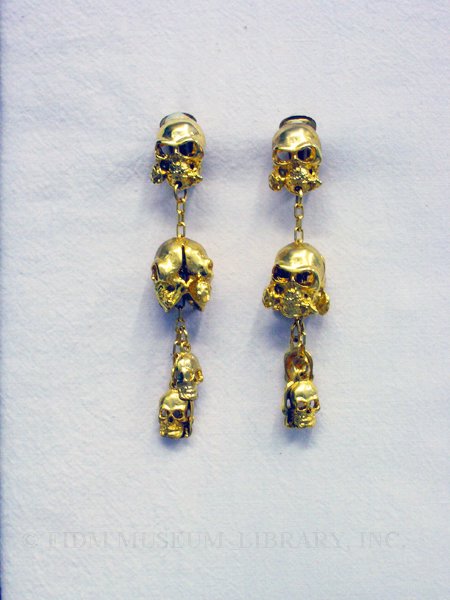For the past few years, skulls have been everywhere, appearing as a motif on hand-knit sweaters, contemporary art, runway fashion, fast fashion and housewares. Despite their current incarnation as overused icon, the skull motif has weighty symbolic meaning. Skulls, skulls and crossbones and skeletons have been used for centuries, probably millennia, as a memento mori, a reminder of the fragility of human life. These same symbols have also functioned as a sign of danger, rebellion or threat, as in the Jolly Roger, the classic skull and crossbones pirate flag. No sober memento mori here, this Versus by Gianni Versace skull bracelet embodies the rebellious, counter-cultural side of the skull motif. Notice that each skull has a rose in its mouth and a raised lion medallion on the forehead.
 Skull bracelet
Skull bracelet
1994
Versus/Gianni Versace
Gift of Dorothy W. Sorensen
V2010.1110.59
Versace, both under Gianni and his sister Donatella, has always embodied a flashy, rebellious, blatantly sexual aesthetic. In the 1990s, Gianni Versace used gold studs, buckles, fringe, safety pins and black leather with abandon. Nodding distantly to both punk fashion and cowboy workwear, these creations were upscale versions of sub-cultural styles. Our Versace fringed leather vest showcases this aspect of the Versace aesthetic. Versace also incorporated religious imagery into his designs, sometimes featuring heavily embellished crosses as a decorative element on an evening dress or jacket. The bracelet and earrings pictured in this post are Versus, Versace's diffusion line. Versus can be considered the wild younger sister of Versace, often pushing the house aesthetic one step further.
Skull earrings
1994
Versus/Gianni Versace
Gift of Dorothy W. Sorensen
V2010.1110.60AB
When skulls are plastered on everything from lunchboxes to bedsheets, do they maintain any emotional resonance? Do they still inspire fear or suggest mortality? Sub-cultural icons and styles are often co-opted and absorbed by the dominant culture, especially in fashion. Fashion writers have suggested that the current popularity of the skull is yet another example of this process, which diminishes the psychological and visual impact of a formerly meaningful icon. In 2006, designer Rick Owens (known for his upscale goth influenced aesthetic) described this phenomenon in relation to the skull when he stated, “The skull was one of the last frontiers. There’s no way to make yourself edgy anymore.”1

Skull & dagger earrings
1994
Versus/Gianni Versace
Gift of Dorothy W. Sorensen
V2010.1110.60AB
The contemporary skull motifs could also be read in a slightly different way, one that suggests new ways of thinking about fashion, beauty and the body. Contemporary "fashion is no longer concerned with producing only images of perfection that smooth out the reality of the body…it now encompasses references to death and decay, uncertainty and yearning" among other difficult emotions.2 The popularity of skull, an unambiguous reminder of death and mourning, reinforces this argument. Its ubiquity strengthens this reading; because it is so widespread, the skull must have significance for the culture in which it appears. This reading of the skull is similar to the more traditional usage of the icon as a memento mori.
Was Versace thinking about these complexities when he designed his skull jewelry for Versus? Probably not. As a designer, he was interested in making an impact on his audience. When this jewelry was created in 1994, the skull had yet to become as widespread as it is now. It still maintained a certain shock value. Versace's use of this icon may have helped spur its mainstream popularity a few years later.
1 Colman, David. "The Heyday of the Dead." New York Times 27 July 2006.
2 Arnold, Rebecca. Fashion, Desire and Anxiety: Image and Morality in the 20th Century. New Jersey: Rutgers. 2001: 125.


